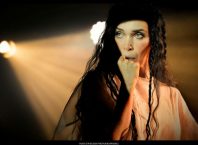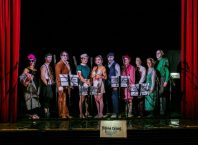“We must not always talk in the market-place of what happens to us in the forest,” says Hester Prynne to her daughter in Nathaniel Hawthorne’s novel The Scarlet Letter. In the market-place, the wares are all out in the open: on display, exposed, as are the people. The tumult of colors, scents and noise, even the ubiquitous plaid plastic carts with wheels – there’s a kind of thrill to it all, and an element of risk. There is no comfortable distance from which to view the market. You are either in or out and you never know what you will see or hear: anything is possible. That is the feeling I had watching Sara Sibony’s theatre group from Jaffa’s Beit Reka perform at the Bat Yam International Street Theatre Festival. An imaginative journey to the unexpected, with its underlying intimations of the secrets of the forest, it was a theatre experience unlike any other.
“Beit Reka is a community center located in Jaffa Daled – it’s a neighborhood with a stigma,” director Sara Sibony told me as we sat in the café at the Tel Aviv Gay Center in Meir Park. She explained that this particular community theatre group has been active for many years. The previous director had worked with them for 11 years straight. When she approached Sibony two and a half years ago to replace her as director, Sibony hesitated. With a background in dance, movement and more experimental theatre, she was not sure that the community theatre environment, with its emphasis on social issues, would be a good match for her. But after meeting the group, “I knew I wanted to work with them. They are people from all walks of life who are interested in theatre. There is a preschool teacher, a graphic designer, a taxi cab driver – it’s a very diverse group.”
Although people have come and gone over the years, the group has been consistently active and serious about their work, some of which was documented in a film by Iris Rubin (Machboim – the Hebrew term for hide and seek) which won the Wolgin Prize for best documentary at the Jerusalem Film Festival in 1998. Prior to the current production, Sibony did a piece with the group that was entirely movement based, called “Man Broom Woman” which explored male-female relationships. Says Sibony, “I wanted to see what I could do with this group, to bring out something different.”
Ati Citron, artistic director of the Bat Yam International Street Theatre Festival invited Sibony and the group to participate in the festival (which is usually open only to professionals), and she started to think of an appropriate project. The idea of having a market grew out of Jaffa itself, as Sibony visited the Agora Gallery, where she saw an exhibit of portraits, and continued from there to the flea market, moving, as she expresses it, “from something very intimate to something very public.” She began working on the idea with the group, starting with making actual self-portraits, and developing it into the concept of putting yourself on the table, your identity, your sense of self on display.
Working in tandem with designer Sivan Weinsten, the central question became: “What do we want to have there? It could be absurd things like “the soul of man” or real things.
Some of the ideas began from the design. Each stand had to originate with the person selling, because you are selling your feelings. We started looking for material and improvising. One woman’s mother was an actress who travelled a lot and was very preoccupied with her image and neglected her children. It was a very painful story that turned into something a little crazy: [in the performance] she turns into her mother. Selling your parents – it’s the worst thing you can say about a person ‘he would sell his own mother’. It’s something everyone can relate to in some way. We wanted to create interaction with the audience.”
The audience experiences a trip to the market in every sense of the word (including the hallucinatory reference) as one wanders through an array of stalls laden with a bizarre assortment of wares and the familiar arias of hawkers compete for your attention with offers of strange goods. “There were many decisions to make – should they all speak at the same time?” recalls Sibony, who concluded, “Yes, it’s a market, people do interrupt and disturb one another. We didn’t dress them in costumes. We collected items for over 6 months from trash bins. It was insane!”
Says Sibony, “In this market nothing is really sold, but everything is offered for sale.
It’s a fiction. The banter, the bargaining is the central element. There was one man who insisted on offering something real – grandfather’s cures. He said: Sara I want there to be one true thing in this market.”
Although none of the performers are professional actors, the “one true thing” in this writer’s estimation is the exceptional theatrical experience. Theatre is created in the interaction between actor/seller and audience, both sides entering an arena in which the outcome depends on the communication between them. In some sense roles are reversed: the audience is free to roam, while the actors are confined in their stalls. It is a theatre of the unexpected: intensely personal, unabashedly uninhibited, a little crazy and lots of fun.





